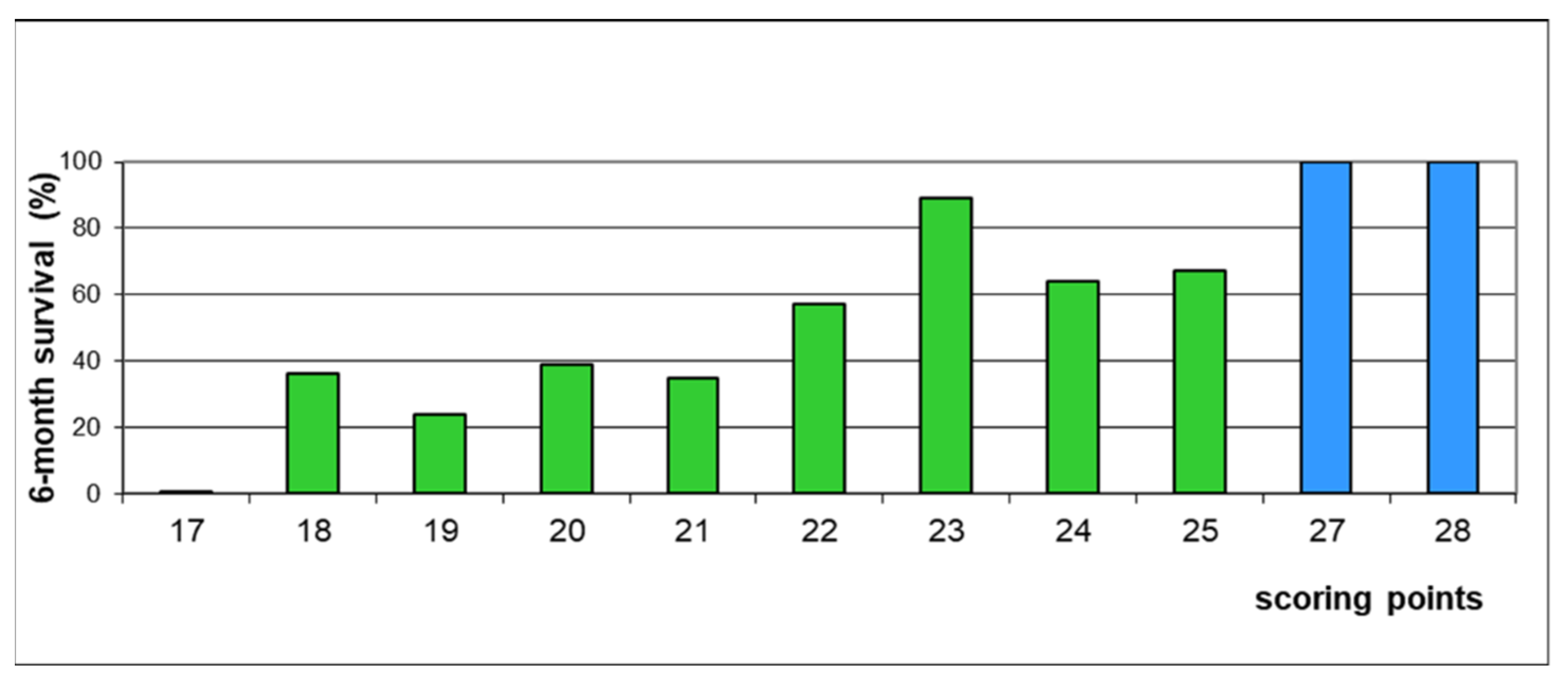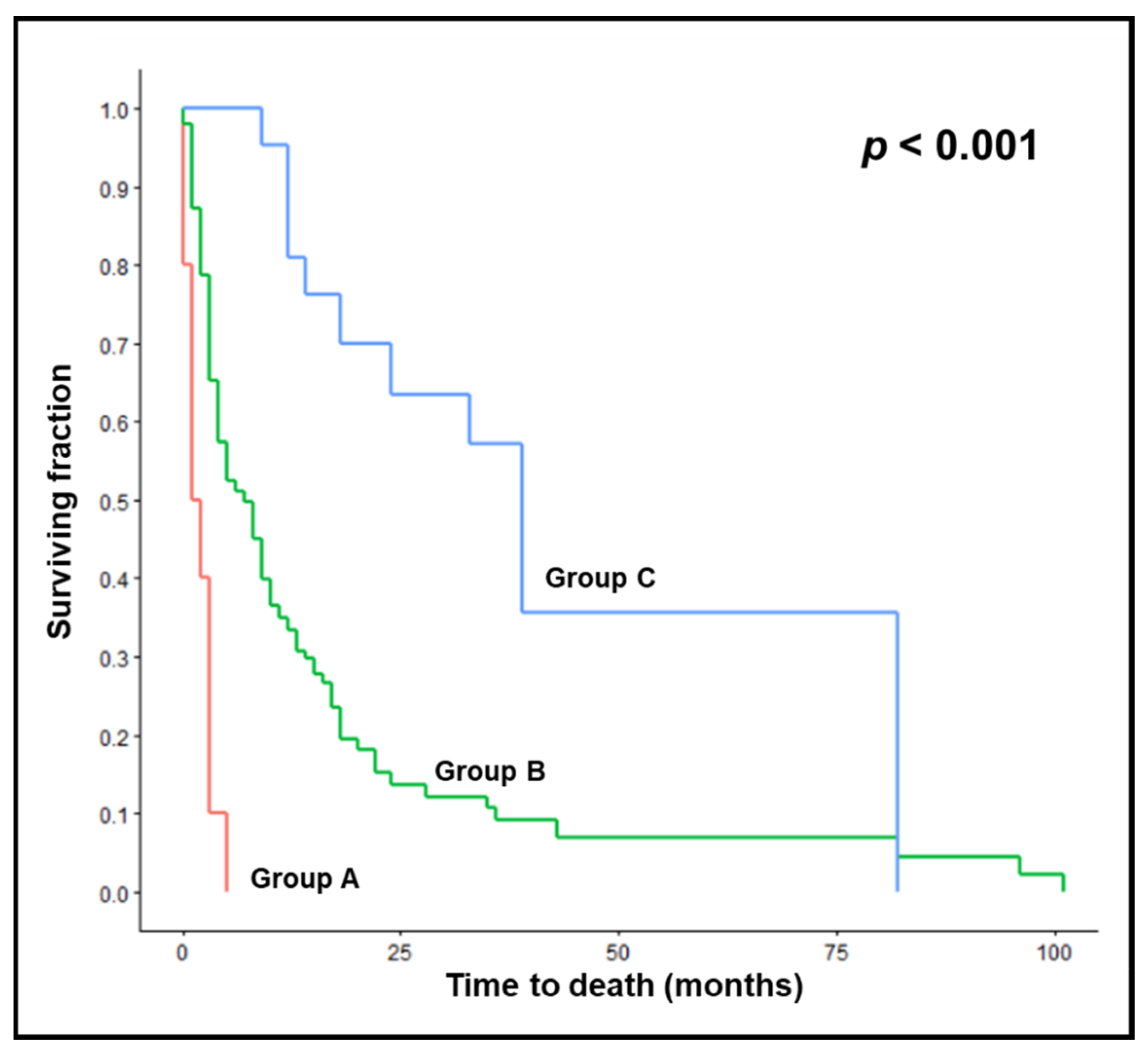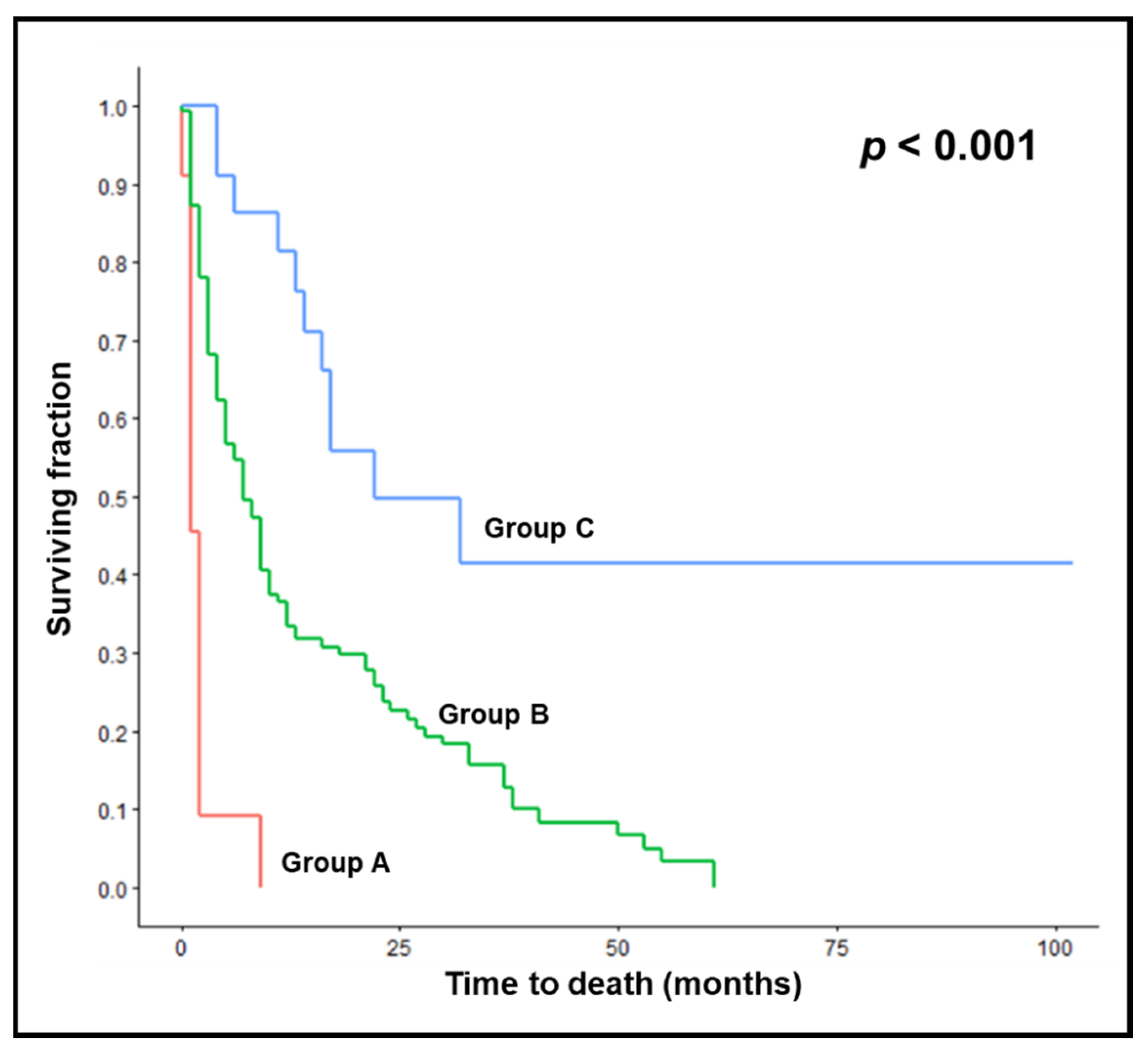A New Survival Score for Patients ≥65 Years Assigned to Radiotherapy of Bone Metastases
Abstract
Simple Summary
Abstract
1. Introduction
2. Materials and Methods
3. Results
4. Discussion
5. Conclusions
Author Contributions
Funding
Institutional Review Board Statement
Informed Consent Statement
Data Availability Statement
Conflicts of Interest
References
- Coleman, R.E. Clinical features of metastatic bone disease and risk of skeletal morbidity. Clin. Cancer Res. 2006, 12, 6243s–6249s. [Google Scholar] [CrossRef] [PubMed]
- Rades, D.; Schild, S.E.; Abrahm, J.L. Treatment of painful bone metastases. Nat. Rev. Clin. Oncol. 2010, 7, 220–229. [Google Scholar] [CrossRef] [PubMed]
- Lutz, S.; Balboni, T.; Jones, J.; Lo, S.; Petit, J.; Rich, S.E.; Wong, R.; Hahn, C. Palliative radiation therapy for bone metastases: Update of an ASTRO Evidence-Based Guideline. Pract. Radiat. Oncol. 2017, 7, 4–12. [Google Scholar] [CrossRef] [PubMed]
- Chow, E.; Zeng, L.; Salvo, N.; Dennis, K.; Tsao, M.; Lutz, S. Update on the systematic review of palliative radiotherapy trials for bone metastases. Clin. Oncol. 2012, 24, 112–124. [Google Scholar] [CrossRef] [PubMed]
- Wu, J.S.; Wong, R.; Johnston, M.; Bezjak, A.; Whelan, T.; Cancer Care Ontario Practice Guidelines Initiative Supportive Care Group. Meta-analysis of dose-fractionation radiotherapy trials for the palliation of painful bone metastases. Int. J. Radiat. Oncol. Biol. Phys. 2003, 55, 594–605. [Google Scholar] [CrossRef]
- Sze, W.M.; Shelley, M.D.; Held, I.; Wilt, T.J.; Mason, M.D. Palliation of metastatic bone pain: Single fraction versus multifraction radiotherapy—A systematic review of randomised trials. Clin. Oncol. 2003, 15, 345–352. [Google Scholar] [CrossRef]
- Chow, E.; Harris, K.; Fan, G.; Tsao, M.; Sze, W.M. Palliative radiotherapy trials for bone metastases: A systematic review. J. Clin. Oncol. 2007, 25, 1423–1436. [Google Scholar] [CrossRef] [PubMed]
- Dennis, K.; Makhani, L.; Zeng, L.; Lam, H.; Chow, E. Single fraction conventional external beam radiation therapy for bone metastases: A systematic review of randomised controlled trials. Radiother. Oncol. 2013, 106, 5–14. [Google Scholar] [CrossRef] [PubMed]
- Chow, R.; Hoskin, P.; Chan, S.; Mesci, A.; Hollenberg, D.; Lam, H.; DeAngelis, C.; Chow, E. Efficacy of multiple fraction conventional radiation therapy for painful uncomplicated bone metastases: A systematic review. Radiother. Oncol. 2017, 122, 323–331. [Google Scholar] [CrossRef]
- Rich, S.E.; Chow, R.; Raman, S.; Liang Zeng, K.; Lutz, S.; Lam, H.; Silva, M.F.; Chow, E. Update of the systematic review of palliative radiation therapy fractionation for bone metastases. Radiother. Oncol. 2018, 126, 547–557. [Google Scholar] [CrossRef]
- Chow, R.; Hoskin, P.; Schild, S.E.; Raman, S.; Im, J.; Zhang, D.; Chan, S.; Chiu, N.; Chiu, L.; Lam, H.; et al. Single vs multiple fraction palliative radiation therapy for bone metastases: Cumulative meta-analysis. Radiother. Oncol. 2019, 141, 56–61. [Google Scholar] [CrossRef] [PubMed]
- Koswig, S.; Budach, V. Remineralization and pain relief in bone metastases after different radiotherapy fractions (10 times 3 Gy vs. 1 time 8 Gy). A prospective study. Strahlenther. Onkol. 1999, 175, 500–508. [Google Scholar] [CrossRef] [PubMed]
- Jensen, G.L.; Gaddipati, R.; Hammonds, K.P.; Morrow, A.; Swanson, G.P. Bone density changes following radiotherapy to vertebral metastases. Cureus 2021, 13, e15417. [Google Scholar] [CrossRef]
- Saad, F.; Gleason, D.M.; Murray, R.; Tchekmedyian, S.; Venner, P.; Lacombe, L.; Chin, J.L.; Vinholes, J.J.; Goas, J.A.; Chen, B.; et al. A randomized, placebo-controlled trial of zoledronic acid in patients with hormone-refractory metastatic prostate carcinoma. J. Natl. Cancer Inst. 2002, 94, 1458–1468. [Google Scholar] [CrossRef] [PubMed]
- Saad, F.; Gleason, D.M.; Murray, R.; Tchekmedyian, S.; Venner, P.; Lacombe, L.; Chin, J.L.; Vinholes, J.J.; Goas, J.A.; Zheng, M.; et al. Long-term efficacy of zoledronic acid for the prevention of skeletal complications in patients with metastatic hormone-refractory prostate cancer. J. Natl. Cancer Inst. 2004, 96, 879–982. [Google Scholar] [CrossRef] [PubMed]
- Stopeck, A.T.; Lipton, A.; Body, J.J.; Steger, G.G.; Tonkin, K.; de Boer, R.H.; Lichinitser, M.; Fujiwara, Y.; Yardley, D.A.; Viniegra, M.; et al. Denosumab compared with zoledronic acid for the treatment of bone metastases in patients with advanced breast cancer: A randomized, double-blind study. J. Clin. Oncol. 2010, 28, 5132–5139. [Google Scholar] [CrossRef]
- Fizazi, K.; Carducci, M.; Smith, M.; Damião, R.; Brown, J.; Karsh, L.; Milecki, P.; Shore, N.; Rader, M.; Wang, H.; et al. Denosumab versus zoledronic acid for treatment of bone metastases in men with castration-resistant prostate cancer: A randomised, double-blind study. Lancet 2011, 377, 813–822. [Google Scholar] [CrossRef]
- Henry, D.H.; Costa, L.; Goldwasser, F.; Hirsh, V.; Hungria, V.; Prausova, J.; Scagliotti, G.V.; Sleeboom, H.; Spencer, A.; Vadhan-Raj, S.; et al. Randomized, double-blind study of denosumab versus zoledronic acid in the treatment of bone metastases in patients with advanced cancer (excluding breast and prostate cancer) or multiple myeloma. J. Clin. Oncol. 2011, 29, 1125–1132. [Google Scholar] [CrossRef]
- van der Linden, Y.M.; Dijkstra, S.P.; Vonk, E.J.; Marijnen, C.A.; Leer, J.W.; Dutch Bone Metastasis Study Group. Prediction of survival in patients with metastases in the spinal column: Results based on a randomized trial of radiotherapy. Cancer 2005, 103, 320–328. [Google Scholar] [CrossRef]
- Rades, D.; Dunst, J.; Schild, S.E. The first score predicting overall survival in patients with metastatic spinal cord compression. Cancer 2008, 112, 157–161. [Google Scholar] [CrossRef]
- Rades, D.; Douglas, S.; Veninga, T.; Stalpers, L.J.; Hoskin, P.J.; Bajrovic, A.; Adamietz, I.A.; Basic, H.; Dunst, J.; Schild, S.E. Validation and simplification of a score predicting survival in patients irradiated for metastatic spinal cord compression. Cancer 2010, 116, 3670–3673. [Google Scholar] [CrossRef] [PubMed]
- Westhoff, P.G.; de Graeff, A.; Monninkhof, E.M.; Bollen, L.; Dijkstra, S.P.; van der Steen-Banasik, E.M.; van Vulpen, M.; Leer, J.W.; Marijnen, C.A.; van der Linden, Y.M.; et al. An easy tool to predict survival in patients receiving radiation therapy for painful bone metastases. Int. J. Radiat. Oncol. Biol. Phys. 2014, 90, 739–747. [Google Scholar] [CrossRef] [PubMed]
- Bollen, L.; van der Linden, Y.M.; Pondaag, W.; Fiocco, M.; Pattynama, B.P.; Marijnen, C.A.; Nelissen, R.G.; Peul, W.C.; Dijkstra, P.D. Prognostic factors associated with survival in patients with symptomatic spinal bone metastases: A retrospective cohort study of 1043 patients. Neuro Oncol. 2014, 16, 991–998. [Google Scholar] [CrossRef] [PubMed]
- Rades, D.; Evers, J.N.; Bajrovic, A.; Veninga, T.; Karstens, J.H.; Schild, S.E. Metastatic spinal cord compression: A validated survival score for elderly patients. Strahlenther. Onkol. 2014, 190, 919–924. [Google Scholar] [CrossRef]
- Willeumier, J.J.; van der Linden, Y.M.; van der Wal, C.W.P.G.; Jutte, P.C.; van der Velden, J.M.; Smolle, M.A.; van der Zwaal, P.; Koper, P.; Bakri, L.; de Pree, I.; et al. An easy-to-use prognostic model for survival estimation for patients with symptomatic long bone metastases. J. Bone Joint Surg. Am. 2018, 100, 196–204. [Google Scholar] [CrossRef] [PubMed]
- Rades, D.; Haus, R.; Schild, S.E.; Janssen, S. Prognostic factors and a new scoring system for survival of patients irradiated for bone metastases. BMC Cancer 2019, 19, 1156. [Google Scholar] [CrossRef] [PubMed]
- Rades, D.; Conde-Moreno, A.J.; Cacicedo, J.; Szegedin, B.; Schild, S.E. Estimating the survival of elderly patients with renal cell carcinoma presenting with malignant spinal cord compression. Anticancer Res. 2016, 36, 409–413. [Google Scholar]
- Rades, D.; Conde-Moreno, A.J.; Cacicedo, J.; Segedin, B.; Veninga, T.; Schild, S.E. Metastatic spinal cord compression: A survival score particularly developed for elderly prostate cancer patients. Anticancer Res. 2015, 35, 6189–6192. [Google Scholar]
- Rades, D.; Conde, A.J.; Garcia, R.; Cacicedo, J.; Segedin, B.; Perpar, A.; Schild, S.E. A new instrument for estimation of survival in elderly patients irradiated for metastatic spinal cord compression from breast cancer. Radiat. Oncol. 2015, 10, 173. [Google Scholar] [CrossRef]
- Rades, D.; Conde-Moreno, A.J.; Segedin, B.; Veninga, T.; Cacicedo, J.; Schild, S.E. A prognostic instrument to estimate the survival of elderly patients irradiated for metastatic epidural spinal cord compression from lung cancer. Clin. Lung Cancer 2016, 17, 279–284. [Google Scholar] [CrossRef]
- Katagiri, H.; Takahashi, M.; Wakai, K.; Sugiura, H.; Kataoka, T.; Nakanishi, K. Prognostic factors and a scoring system for patients with skeletal metastasis. J. Bone Joint Surg. Br. 2005, 87, 698–703. [Google Scholar] [CrossRef] [PubMed]
- Katagiri, H.; Okada, R.; Takagi, T.; Takahashi, M.; Murata, H.; Harada, H.; Nishimura, T.; Asakura, H.; Ogawa, H. New prognostic factors and scoring system for patients with skeletal metastasis. Cancer Med. 2014, 3, 1359–1367. [Google Scholar] [CrossRef]
- Felder, S. The Impact of Demographic Change on Healthcare Expenditure, CESifo DICE Report; ifo Institut—Leibniz-Institut für Wirtschaftsforschung an der Universität München: München, Germany, 2013; Volume 11, pp. 3–6. [Google Scholar]
- Yang, F.; Wang, J.F.; Wang, Y.; Liu, B.; Molina, J.R. Comparative analysis of predictive biomarkers for PD-1/PD-L1 inhibitors in cancers: Developments and challenges. Cancers 2021, 14, 109. [Google Scholar] [CrossRef] [PubMed]
- De Mello, R.A.B.; Voscaboinik, R.; Luciano, J.V.P.; Cremonese, R.V.; Amaral, G.A.; Castelo-Branco, P.; Antoniou, G. Immunotherapy in patients with advanced non-small cell lung cancer lacking driver mutations and future perspectives. Cancers 2021, 14, 122. [Google Scholar] [CrossRef]
- Alharbi, K.S.; Javed Shaikh, M.A.; Afzal, O.; Alfawaz Altamimi, A.S.; Almalki, W.H.; Alzarea, S.I.; Kazmi, I.; Al-Abbasi, F.A.; Singh, S.K.; Dua, K.; et al. An overview of epithelial growth factor receptor (EGFR) inhibitors in cancer therapy. Chem. Biol. Interact. 2022, 366, 110108. [Google Scholar] [CrossRef]
- Melosky, B.; Cheema, P.; Agulnik, J.; Albadine, R.; Bebb, D.G.; Blais, N.; Burkes, R.; Butts, C.; Card, P.B.; Chan, A.M.Y.; et al. Canadian perspectives: Update on inhibition of ALK-positive tumours in advanced non-small-cell lung cancer. Curr. Oncol. 2018, 25, 317–328. [Google Scholar] [CrossRef] [PubMed]



| Potential Prognostic Factor | Test Cohort n Patients (%) | Validation Cohort n Patients (%) | p-Value |
|---|---|---|---|
| Age | 0.67 | ||
| 65–74 years | 96 (55) | 100 (57) | |
| ≥75 years | 78 (45) | 74 (43) | |
| Gender | 0.45 | ||
| Female | 79 (45) | 72 (41) | |
| Male | 95 (55) | 102 (59) | |
| ECOG performance score | 0.2 | ||
| 0–1 | 84 (48) | 96 (55) | |
| ≥2 | 90 (52) | 78 (45) | |
| Primary tumor type | 0.82 | ||
| Breast cancer | 45 (26) | 38 (22) | |
| Prostate cancer | 35 (20) | 37 (21) | |
| Lung cancer | 53 (30) | 53 (30) | |
| Kidney cancer | 8 (5) | 11 (6) | |
| Colorectal cancer | 8 (5) | 4 (2) | |
| Cancer of unknown primary | 6 (3) | 8 (5) | |
| Other tumors | 19 (11) | 23 (13) | |
| Interval from tumor diagnosis to RT | 0.33 | ||
| ≤8 months | 78 (45) | 87 (50) | |
| >8 months | 96 (55) | 87 (50) | |
| Visceral metastases | 0.086 | ||
| No | 92 (53) | 76 (44) | |
| Yes | 82 (47) | 98 (56) | |
| Other bone metastases | 1 | ||
| No | 59 (34) | 59 (34) | |
| Yes | 115 (66) | 115 (66) | |
| Upfront surgery | 0.019 | ||
| No | 133 (76) | 150 (86) | |
| Yes | 41 (24) | 24 (14) | |
| Pre-RT systemic therapy | 0.36 | ||
| No | 51 (29) | 59 (34) | |
| Yes | 123 (71) | 115 (66) | |
| Site(s) of irradiated lesions | 0.84 | ||
| Spinal only | 65 (37) | 60 (35) | |
| Non-spinal only | 61 (35) | 65 (37) | |
| Both | 48 (28) | 49 (28) | |
| Number of irradiated lesions | 0.67 | ||
| n = 1 | 80 (46) | 76 (44) | |
| n ≥ 2 | 94 (54) | 98 (56) | |
| Period of radiotherapy (years) | 0.91 | ||
| 2009–2017 | 114 (66) | 112 (64) | |
| 2018–2022 | 60 (34) | 62 (36) | |
| Radiotherapy dose (EQD2) | 0.25 | ||
| <32.5 Gy | 20 (12) | 26 (15) | |
| 32.5 Gy (10 × 3 Gy) | 89 (51) | 74 (43) | |
| >32.5 Gy | 65 (37) | 74 (43) |
| Potential Prognostic Factor | Survival Rates at 6 Months (%) | Survival Rates at 12 Months (%) | p-Value |
|---|---|---|---|
| Age | 0.37 | ||
| 65–74 years | 50 | 31 | |
| ≥75 years | 60 | 46 | |
| Gender | <0.001 | ||
| Female | 65 | 49 | |
| Male | 46 | 28 | |
| ECOG performance score | <0.001 | ||
| 0–1 | 73 | 57 | |
| ≥2 | 38 | 20 | |
| Primary tumor type | <0.001 | ||
| Breast cancer | 78 | 59 | |
| Prostate cancer | 69 | 47 | |
| Lung cancer | 34 | 29 | |
| Kidney cancer | 50 | 13 | |
| Colorectal cancer | 50 | 13 | |
| Cancer of unknown primary | 33 | 33 | |
| Other tumors | 42 | 21 | |
| Interval from tumor diagnosis to RT | 0.4 | ||
| ≤8 months | 46 | 36 | |
| >8 months | 61 | 39 | |
| Visceral metastases | 0.009 | ||
| No | 60 | 45 | |
| Yes | 49 | 30 | |
| Other bone metastases | 0.36 | ||
| No | 53 | 39 | |
| Yes | 56 | 37 | |
| Upfront surgery | 0.42 | ||
| No | 52 | 37 | |
| Yes | 63 | 41 | |
| Pre-RT systemic therapy | 0.38 | ||
| No | 47 | 32 | |
| Yes | 58 | 40 | |
| Site(s) of irradiated lesions | 0.74 | ||
| Spinal only | 58 | 38 | |
| Non-spinal only | 51 | 36 | |
| Both | 54 | 40 | |
| Number of irradiated lesions | 0.99 | ||
| n = 1 | 54 | 40 | |
| n ≥ 2 | 55 | 36 | |
| Period of radiotherapy (years) | 0.51 | ||
| 2009–2017 | 57 | 39 | |
| 2018–2022 | 50 | 36 | |
| Radiotherapy dose (EQD2) | 0.29 | ||
| <32.5 Gy | 55 | 25 | |
| 32.5 Gy (10 × 3 Gy) | 56 | 44 | |
| >32.5 Gy | 52 | 32 |
| Characteristic | Survival Rate at 6 Months (%) | Scoring Points |
|---|---|---|
| Gender | ||
| Female | 65 | 7 |
| Male | 46 | 5 |
| ECOG performance score | ||
| 0–1 | 73 | 7 |
| 2–3 | 38 | 4 |
| Primary tumor type | ||
| Breast cancer | 78 | 8 |
| Prostate cancer | 69 | 7 |
| Lung cancer | 34 | 3 |
| Kidney cancer | 50 | 5 |
| Colorectal cancer | 50 | 5 |
| Cancer of unknown primary | 33 | 3 |
| Other tumors | 42 | 4 |
| Visceral metastases | ||
| No | 60 | 6 |
| Yes | 49 | 5 |
Publisher’s Note: MDPI stays neutral with regard to jurisdictional claims in published maps and institutional affiliations. |
© 2022 by the authors. Licensee MDPI, Basel, Switzerland. This article is an open access article distributed under the terms and conditions of the Creative Commons Attribution (CC BY) license (https://creativecommons.org/licenses/by/4.0/).
Share and Cite
Rades, D.; Delikanli, C.; Schild, S.E.; Kristiansen, C.; Tvilsted, S.; Janssen, S. A New Survival Score for Patients ≥65 Years Assigned to Radiotherapy of Bone Metastases. Cancers 2022, 14, 4679. https://doi.org/10.3390/cancers14194679
Rades D, Delikanli C, Schild SE, Kristiansen C, Tvilsted S, Janssen S. A New Survival Score for Patients ≥65 Years Assigned to Radiotherapy of Bone Metastases. Cancers. 2022; 14(19):4679. https://doi.org/10.3390/cancers14194679
Chicago/Turabian StyleRades, Dirk, Cansu Delikanli, Steven E. Schild, Charlotte Kristiansen, Søren Tvilsted, and Stefan Janssen. 2022. "A New Survival Score for Patients ≥65 Years Assigned to Radiotherapy of Bone Metastases" Cancers 14, no. 19: 4679. https://doi.org/10.3390/cancers14194679
APA StyleRades, D., Delikanli, C., Schild, S. E., Kristiansen, C., Tvilsted, S., & Janssen, S. (2022). A New Survival Score for Patients ≥65 Years Assigned to Radiotherapy of Bone Metastases. Cancers, 14(19), 4679. https://doi.org/10.3390/cancers14194679






